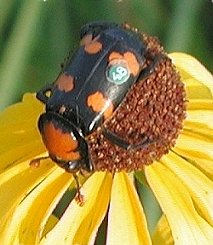Related Research Articles

Burying beetles or sexton beetles, genus Nicrophorus, are the best-known members of the family Silphidae. Most of these beetles are black with red markings on the elytra (forewings). Burying beetles are true to their name—they bury the carcasses of small vertebrates such as birds and rodents as a food source for their larvae. They are unusual among insects in that both the male and female parents take care of the brood. They are carnivores.

Wasps of the genus Sphex are cosmopolitan predators that sting and paralyze prey insects. Sphex is one of many genera in the old digger wasp family Sphecidae, though most apart from the Sphecinae have now been moved to the family Crabronidae. There are over 130 known Sphex species.

The genus Halictus is a large assemblage of bee species in the family Halictidae. The genus is divided into 15 subgenera, some of dubious monophyly, containing over 200 species, primarily in the Northern Hemisphere. Most species are black or dark brown, sometimes metallic greenish-tinted, with apical whitish abdominal bands on the terga.

Onciderini is a tribe of longhorn beetles of the subfamily Lamiinae, they are prevalent across Europe in nations such as Turkey, and Finland.
Tylopilus funerarius is a bolete fungus in the family Boletaceae. Found in Singapore, it was described as new to science in 1909 by English mycologist George Edward Massee. He described it as a "sombre, uninviting species, characterised by brownish-black velvety pileus and brown tube and pores", and considered it similar in appearance to Boletus chrysenteron. The species was transferred to the genus Tylopilus in 1981.
Clavidesmus is a genus of longhorn beetles of the subfamily Lamiinae, containing the following species:
Clavidesmus chicae is a species of beetle in the family Cerambycidae. It was described by Giorgi in 1998. It is known from Brazil.
Clavidesmus columbianus is a species of beetle in the family Cerambycidae. It was described by Stephan von Breuning in 1961. It is known from Colombia.
Clavidesmus heterocerus is a species of beetle in the family Cerambycidae. It was described by Buquet in 1852. It is known from Paraguay and Brazil.
Clavidesmus indistinctus is a species of beetle in the family Cerambycidae. It was described by Dillon and Dillon in 1952. It is known from Brazil.
Clavidesmus lichenigerus is a species of beetle in the family Cerambycidae. It was described by Lane in 1958, originally under the genus Orteguaza. It is known from Peru, Colombia, Brazil, and Honduras.
Clavidesmus metallicus is a species of beetle in the family Cerambycidae. It was described by James Thomson in 1868. It is known from French Guiana.
Clavidesmus monnei is a species of beetle in the family Cerambycidae. It was described by Giorgi in 1998. It is known from Brazil.
Clavidesmus rubigineus is a species of beetle in the family Cerambycidae. It was described by Dillon and Dillon in 1949. It is known from Brazil.
References
- ↑ BioLib.cz - Clavidesmus funerarius. Retrieved on 8 September 2014.